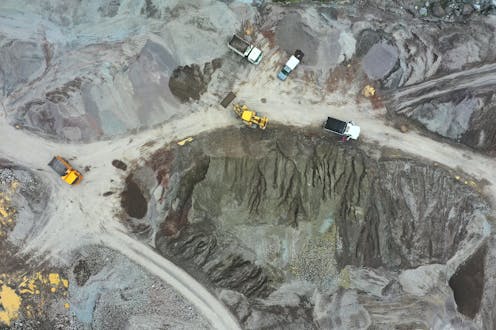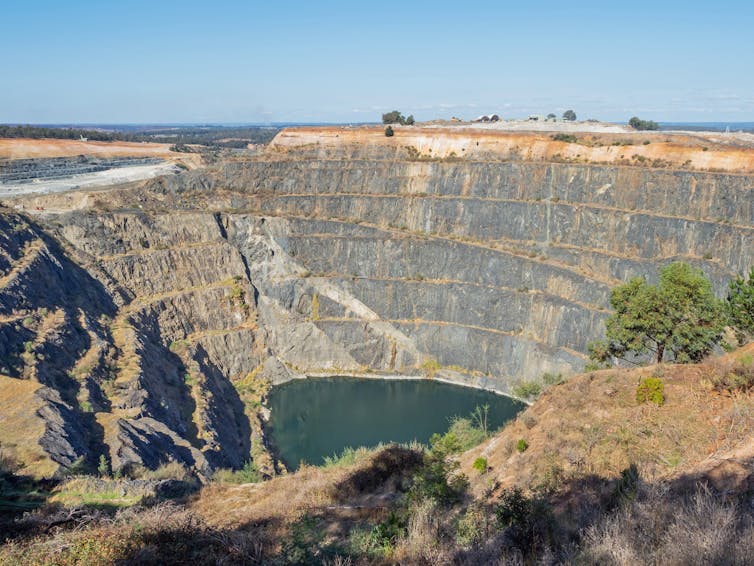
Globalisation is on shaky ground. As China rises, the United States and its allies are moving to reduce their reliance on the world’s factory.
The rivalry between the US and China is wide-ranging, from competition in technology over silicon chips and artificial intelligence to the critical minerals essential for green energy technologies such as grid batteries, wind turbines and electric vehicles.
At present, China dominates critical minerals. Beijing has secured supplies of rare earth elements and lithium, which have enabled it to take the lead in many green tech sectors, from solar to EVs. This has heightened geopolitical volatility.
But it also offers Australia a new pathway to export success – as well as fresh risks. A key part of the government’s flagship Future Made in Australia Act is an effort to fast-track mining of critical minerals – elements such as cobalt and lithium essential to the green energy transition.
That’s great. But who will buy them? If tensions between the US and China force us to pick a side, we might not be able to export our wealth of critical minerals to China, our largest customer.

What’s so important about Australia’s critical minerals?
Thermal and metallurgical coal, iron ore and gold have long dominated our mining exports. But this is changing. Under Australian soils are some of the world’s largest recoverable critical mineral deposits, including cobalt, lithium, manganese, rare earth elements, tungsten and vanadium.
Two years ago, the US government introduced the Inflation Reduction Act, an enormous stimulus bill aimed at speeding up the green transition. But it also contains nationalistic elements, prioritising American industries, workers and technologies over foreign competitors. The US also spearheaded a new multilateral Minerals Security Partnership aimed at reducing reliance on China.
Australia is one of the few mineral suppliers in the partnership. Most members are on the demand side, each with distinct mineral priorities for their industrial, technological and defence needs.
On budget night last week, Treasurer Jim Chalmers said the A$22.7 billion Future Made in Australia package “will help make us an indispensable part of the global economy”.
The framing is clear: Australia will mine and supply critical minerals for nations such as America, which is increasingly integrating us into its plans to reduce reliance on China.
About $7 billion of the Future Made funding will go to downstream refining and processing of the 31 critical minerals we have in deposits worth mining over the medium term.
These plans do not stand alone. They’re in part a response to other nation’s plans to boost processing and production, especially America, which will need reliable mineral sources to go green.
Who else is rich in critical minerals? Other middle-power, mineral-rich countries such as Argentina, Chile, Indonesia and Malaysia. These nations, by contrast, do not align their interests as closely with US strategies as Australia does.
China plays a critical role here as a technology and investment partner, enabling these nations to keep a larger share of economic benefits.
Mineral-rich countries in Africa and other parts of the global south are focused on attracting investment for mineral extraction and mining to achieve immediate economic returns and infrastructure development. Here, too, China has secured access to many important mines in these regions.
Both groups are competitors to Australia.
Over the past two decades, China has secured diverse sources of minerals and developed advanced mineral recycling technologies to reduce its reliance on the global supply of these resources.
It has also advanced its processing capabilities for most of these minerals.
China’s dominance of downstream green tech sectors has given it overcapacity. This enables Beijing to use its market power to significantly influence global supplies of critical minerals.
In response, nations like the US have slapped tariffs on Chinese electric vehicles and batteries.
The risk for Australia
Politically, Australia’s decision to align closely with the US on critical minerals presents substantial risks.
For instance, to qualify for US government green subsidies, Australian mining companies must ensure Chinese companies or funds hold less than 25% ownership. The world’s largest hard-rock lithium mine, Greenbushes in Western Australia, is 26% owned by China’s Tianqi Lithium Energy.

As a result, such mining firms are having to reassess their relationship with Chinese companies and entities.
Chinese battery giants such as CATL and BYD that have partnerships or supply deals with Australian miners may respond by shifting their sourcing
For decades, Australia has tried to walk a tightrope between America, our military backer, and China, our top customer for minerals and ore. This is becoming less and less possible, as US-China tensions increase.
If Australia has to pick a side and decouple from China, it will hit our export revenues hard. Finding alternative markets with ore-processing capacities comparable to China’s will be challenging.
China remains a key export destination for Australia’s critical minerals. For instance, 97% of its lithium is exported to China. Lithium exports earned A$11.7 billion in the first half of 2023. Lithium has now overtaken liquefied natural gas (LNG) as Australia’s second-biggest export to China by revenue, behind iron ore.
What about processing the minerals here? To match China here would require massive investment, a large skilled workforce, huge scale and prolonged effort.
And even if we do, we might end up stuck being able to export these minerals to America and other partnership nations only when supplies from China are disrupted. If that happens, we might be confined to a niche role.
Can we think differently?
So what should we do? Rather than just competing for a share of green manufacturing, Australia should focus on developing enabling technologies, such as automated production lines and robotics for solar panel and battery manufacturing, as well as next-generation fireproof battery materials.
If the government takes the lead on building shared-use infrastructure such as laboratory facilities, transport and mineral processing hubs, it will help attract investors, inventors and entrepreneurs by reducing upfront capital costs and operational risks.
Success in these general-purpose technologies will position Australia as a unique and irreplaceable player in the global critical mineral supply chain.
The authors do not work for, consult, own shares in or receive funding from any company or organisation that would benefit from this article, and have disclosed no relevant affiliations beyond their academic appointment.
This article was originally published on The Conversation. Read the original article.







